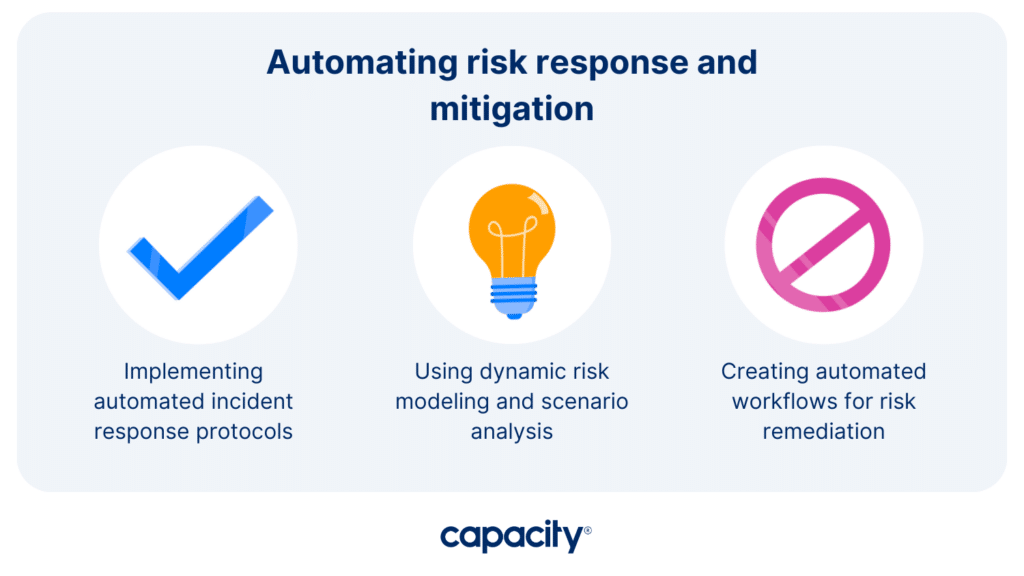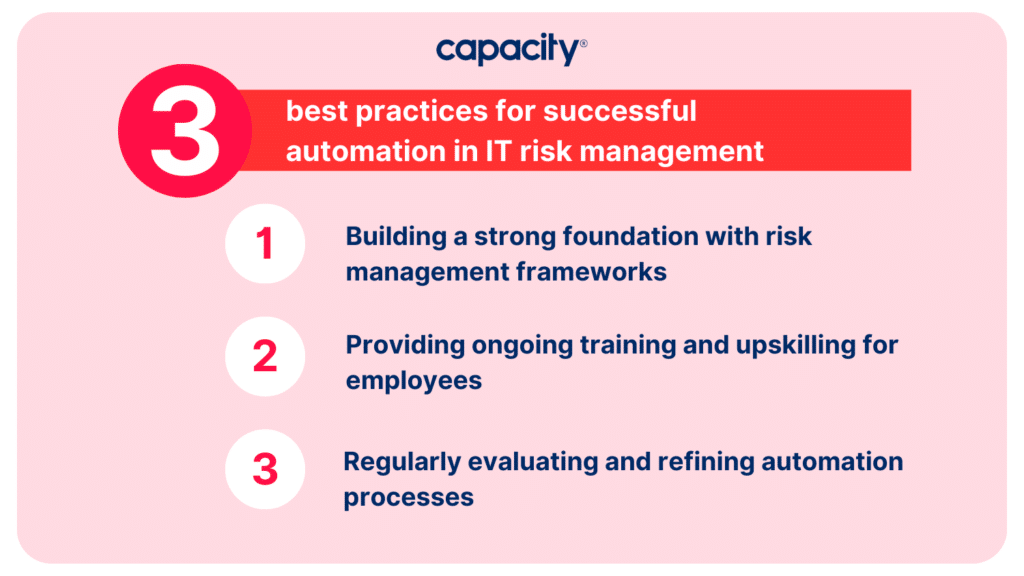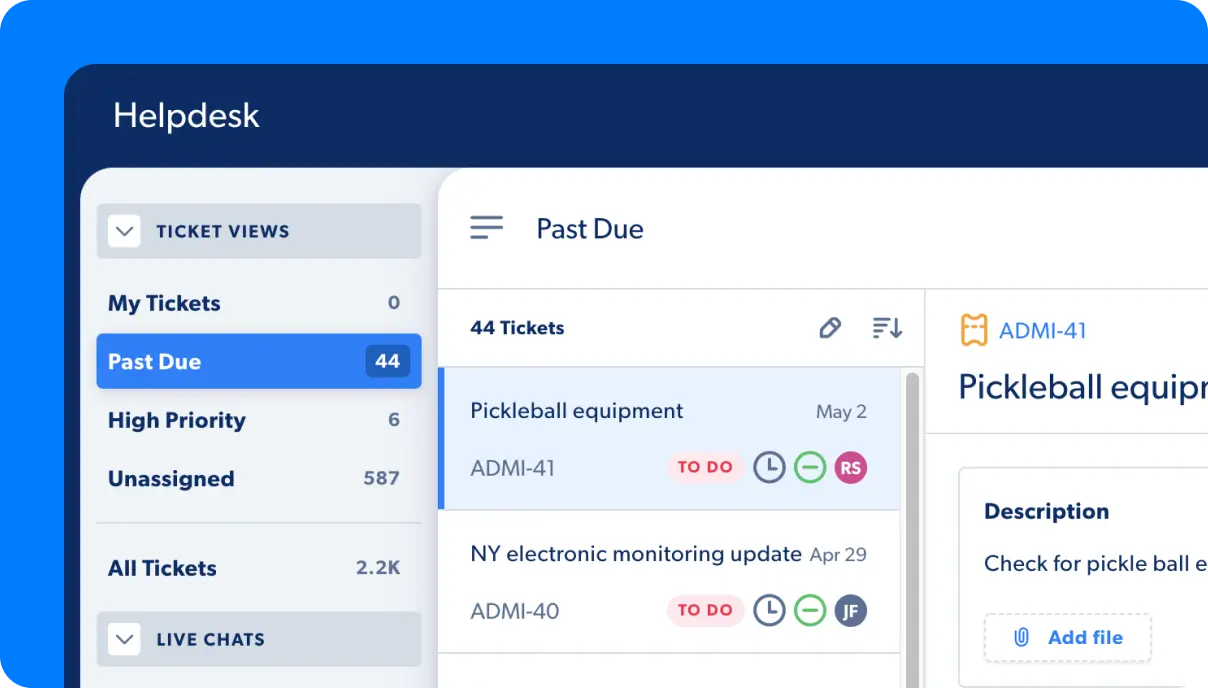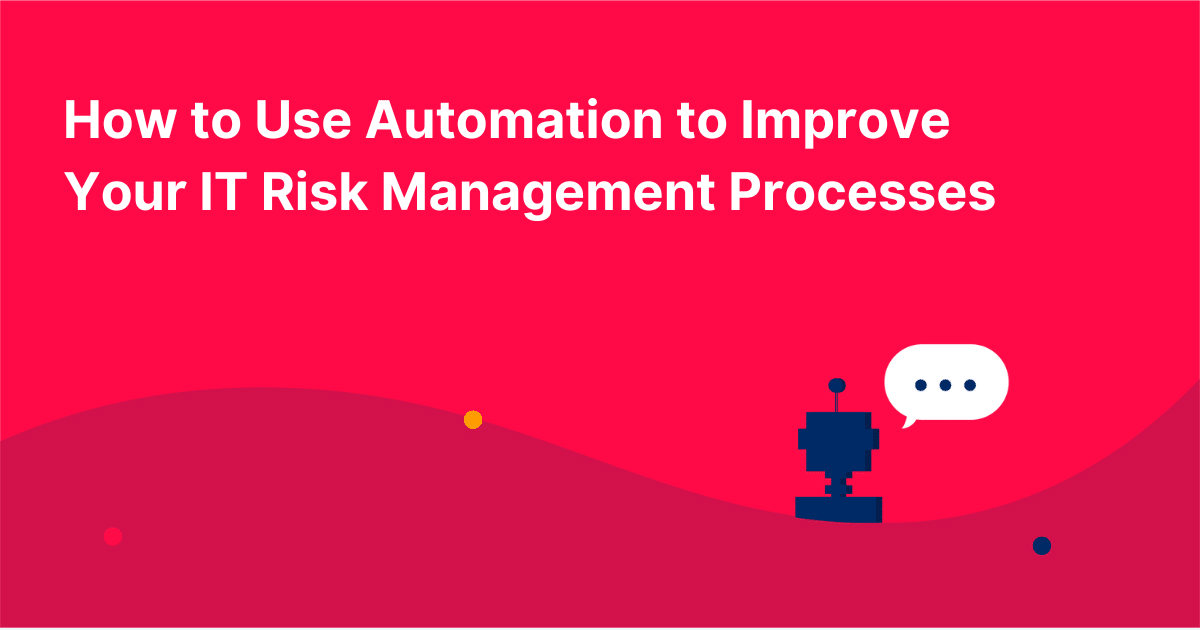Effective IT risk management is crucial for organizations to safeguard sensitive data, protect their systems from cyber threats, and ensure business continuity. Automation can become overwhelming and prone to errors. However, by tapping into the power of automation, IT professionals can streamline their risk management practices, enhance efficiency, and improve overall cybersecurity. It can also help offset hiring difficulties. Did you know that 40% of IT leaders say cybersecurity roles are the most difficult to fill?
Keep reading to explore the role of automation in IT risk management, its advantages, implementation strategies, and best practices for successful automation.

Automate Your Work
Capacity’s enterprise AI chatbot can help:
- Answer FAQs anytime, anywhere
- Find relevant documents within seconds
- Give surveys and collect feedback
The role of automation in IT risk management
Automation is pivotal in managing risk, revolutionizing how organizations identify, assess, respond to, and mitigate risks. Your business can use automated tools and technologies to enhance its risk management processes, mitigate potential vulnerabilities, and stay ahead of evolving threats. More than three-quarters of businesses use automation for standardizing or automating daily workflows. And more than 58% use it to automate data and reporting for planning, and another 36% use it for regulating compliance.
So, let’s explore the profound advantages of automation in managing risk and how it revolutionizes organizational risk-related processes. You can use the power of automation for your business to transform its approach to identifying, assessing, responding to, and mitigating risks, leading to streamlined operations, heightened efficiency, and strengthened cybersecurity measures. Automation brings forth a range of significant benefits in managing risk that organizations can leverage to their advantage.
Furthermore, automation ensures consistent enforcement of risk management policies throughout the organization. Organizations can enforce standardized risk management practices across various departments and units by establishing automated workflows and protocols. This consistency helps establish a robust security posture, minimizes oversight or non-compliance risk, and fosters stakeholders’ trust.
These advantages illustrate the transformative power of automation in IT risk management. Embrace automation, and your business can elevate its risk management practices to new heights, optimize resource allocation, and proactively address emerging threats. Automation integration enables organizations to stay ahead of evolving risks, enhance their cybersecurity defenses, and ensure a resilient and secure IT infrastructure.
A look at a few advantages of automation

1. Improved efficiency and accuracy
Firstly, automation eliminates manual, time-consuming tasks, allowing IT professionals to focus on higher-value activities. When automating routine processes such as data collection, risk assessment, and reporting, you can significantly reduce the risk of human error and improve operational efficiency. This enables IT teams to allocate resources effectively and proactively address critical risks.
2. Streamlined data collection and analysis
Data collection and analysis are integral components of effective IT risk management. Automation tools enable organizations to collect data from various sources, consolidate it in a centralized repository, and perform a comprehensive analysis. By using automation, IT professionals can access real-time insights, identify patterns, and detect potential risks more efficiently. Thus, this leads to better decision-making and enables proactive risk mitigation.
3. Real-time monitoring and response
In the digital landscape, risks can emerge at any time. Automation empowers organizations to implement real-time monitoring systems that continuously assess the IT environment for potential threats. IT teams can respond swiftly to incidents, reducing the impact of security breaches and minimizing downtime with alerts and messages. Real-time monitoring also provides valuable insights into emerging risks, enabling organizations to proactively adapt their risk management strategies.
4. Consistent enforcement of risk management policies
Automation ensures consistent application of risk management policies across the organization. Establishing automated workflows and protocols helps your company enforce standardized risk management practices and minimize the risk of oversight or non-compliance. Consistency in risk management processes helps establish a strong security posture and fosters stakeholder trust.
Identifying areas for automation
Organizations need to thoroughly identify areas within their risk management processes that can benefit from automation to effectively leverage automation in IT risk management. Follow a systematic approach so your team can pinpoint specific tasks and processes that can be streamlined and optimized through automation. Here are some steps that can help organizations identify such areas and unlock the full potential of automation in IT risk management:

- Conducting a comprehensive risk assessment
Performing a thorough risk assessment is the first step toward identifying areas for automation. Evaluate your organization’s risk landscape, prioritize risks based on their potential impact, and identify processes that can be automated to enhance risk mitigation efforts.
- Identifying repetitive and manual tasks
Repetitive and manual tasks are prime candidates for automation. Identify tasks that consume significant time and resources, such as data entry, report generation, or vulnerability scanning. Automating these tasks can free up valuable resources and accelerate risk management processes.
- Evaluating existing processes for automation potential
Assess your existing risk management processes to identify areas that automation can improve. Look for bottlenecks, inefficiencies, and areas where automation can enhance accuracy, speed, and effectiveness.
Implementing automation tools in risk management
Once you have identified areas within your risk management processes that can benefit from automation, the next crucial step is carefully selecting the appropriate automation software or platforms. Implementing automation tools requires thoughtful consideration of various factors to ensure seamless integration and maximize the benefits. Here are some important factors to consider when implementing automation tools in IT risk management
Organizations can select the most suitable automation tools or platforms for their IT risk management needs. This thoughtful selection process sets the foundation for successful automation implementation and paves the way for enhanced risk management practices, improved operational efficiency, and strengthened cybersecurity measures.

Selecting appropriate automation software or platforms
Evaluate different automation software or platforms based on your organization’s needs and requirements. Look for tools that offer data integration, workflow management, reporting capabilities, and scalability. Choose a solution that aligns with your risk management goals and integrates seamlessly with existing systems.
Begin by assessing your organization’s specific requirements and objectives for automation. Determine the essential key functionalities and features to address the identified areas for automation. This will help you select automation tools that align with your organization’s unique needs and goals.
Integrating automation with existing risk management systems
Integrate automation tools with your organization’s existing risk management systems to ensure a smooth transition. This allows for seamless data flow, avoids duplication of efforts, and enables comprehensive risk visibility across the organization. Integration also facilitates the automation of end-to-end risk management processes.
Ensure the automation tools integrate seamlessly with your existing risk management systems, such as governance, risk, and compliance (GRC) platforms, incident management tools, or security information and event management (SIEM) solutions. Smooth integration enables data sharing, centralized reporting, and holistic risk visibility across the organization.
Ensuring compatibility and interoperability with IT infrastructure
Before implementing automation tools, verify their compatibility and interoperability with your organization’s IT infrastructure. Ensure the tools seamlessly integrate with your network, security systems, and other relevant technologies. This prevents any disruptions and guarantees a cohesive risk management ecosystem.
Ensure that your chosen automation tools are compatible with your existing IT infrastructure, systems, and applications. Consider compatibility with different operating systems, database systems, network protocols, and security frameworks. Interoperability with other risk management tools and platforms is crucial for seamless data integration and information flow.
Enhancing risk identification and assessment through automation
Risk identification and assessment processes are vital components of IT risk management, and automation can significantly drive improvements in this area. Your business can streamline and optimize how they identify and assess risks, leading to more accurate and efficient risk management practices. Here’s a closer look at how automation can be leveraged to enhance risk identification and assessment in IT risk management:
Automating data collection and analysis
Collecting and analyzing vast amounts of data manually can be time-consuming and error-prone. Automation tools enable organizations to automate data collection from various sources, such as security logs, network monitoring tools, and vulnerability scanners. You can gain actionable insights and detect risks more effectively by reviewing data in a centralized repository and leveraging advanced analytics.
Harnessing machine learning and AI algorithms for risk scoring
Machine learning and AI algorithms can revolutionize risk scoring by analyzing historical data, identifying patterns, and predicting potential risks. You can develop risk-scoring models that accurately assess threats and vulnerabilities. This empowers organizations to prioritize their risk mitigation efforts and allocate resources accordingly.
Enabling continuous monitoring and early warning systems
Automation enables continuous monitoring of IT systems, networks, and applications. Organizations can detect anomalies, unusual activities, or potential security breaches by implementing automated monitoring tools in real-time. Early detection allows for prompt response and minimizes the impact of security incidents.
Automating risk response and mitigation
Automation can streamline risk response and mitigation efforts, ensuring a swift and effective response to security incidents. Here are a few ways organizations can leverage automation in this regard:

- Implementing automated incident response protocols
Automation enables organizations to define and implement incident response protocols that trigger automatically when specific events or incidents occur. When predefining response actions, you can minimize response time, mitigate potential damages, and ensure consistency in incident handling.
- Using dynamic risk modeling and scenario analysis
Automation tools facilitate dynamic risk modeling and scenario analysis, allowing organizations to simulate potential risks and their impact. Creating automated workflows for scenario analysis, your business can assess the effectiveness of different risk mitigation strategies and optimize their response plans.
- Creating automated workflows for risk remediation
Automation enables the creation of workflows that automate risk remediation processes. Organizations can ensure a timely and consistent response to identified risks by defining standardized workflows for risk remediation. Automated workflows guide IT professionals through the necessary steps, reducing the risk of errors and enhancing overall efficiency.
Overcoming challenges and considerations
While automation brings numerous benefits to IT risk management, organizations need to address certain challenges and considerations:
- Balancing automation with human expertise and judgment
Automation should augment human expertise rather than replace it. Balancing automation and human judgment is essential to ensure effective risk management. While automation can enhance efficiency and accuracy, human expertise is crucial for complex decision-making, risk assessment, and adaptation to emerging threats.
- Addressing data privacy and security concerns
As automation involves handling sensitive data, organizations must prioritize data privacy and security. Implement robust security measures, encryption techniques, and access controls to safeguard sensitive information. Ensure compliance with relevant data protection regulations and establish processes for secure data handling throughout the automation lifecycle.
- Establishing robust governance and oversight mechanisms
Automation should be implemented within a framework of governance and oversight. Establish clear policies, guidelines, and responsibilities regarding automation in IT risk management. Monitor and audit automated processes to ensure compliance, accuracy, and effectiveness. Implement mechanisms for feedback, continuous improvement, and risk management oversight.
A few best practices for successful automation in IT risk management
To ensure successful automation in IT risk management, consider the following best practices:

- Building a strong foundation with risk management frameworks
To establish a solid foundation, adopt recognized risk management frameworks, such as ISO 31000 or NIST Cybersecurity Framework. These frameworks provide guidance and best practices for effective risk management, which can be integrated into automated processes.
- Providing ongoing training and upskilling for employees
Automation requires skilled professionals who can understand and manage automated risk management processes. Provide regular training and upskilling opportunities to your IT team to enhance their knowledge of automation tools, data analysis, and emerging risk trends. This ensures that employees can effectively leverage automation for risk management.
- Regularly evaluating and refining automation processes
Automation is not a one-time implementation; it requires continuous evaluation and refinement. Regularly assess the effectiveness of automated processes, gather stakeholder feedback, and make necessary adjustments. This iterative approach ensures that automation aligns with evolving risk landscapes and organizational needs.
Automation has become a game-changer in IT risk management, enabling organizations to enhance efficiency, accuracy, and effectiveness in identifying, assessing, responding to, and mitigating risks. Streamline data collection and analysis, enable real-time monitoring, enforce risk management policies consistently, and enhance overall risk management practices. However, successful automation requires careful planning, integration with existing systems, addressing challenges, and following best practices. You can strengthen your cybersecurity posture, proactively manage risks, and safeguard your company’s digital assets when you embrace automation in IT risk management.

Automate Your Work
Capacity’s enterprise AI chatbot can help:
- Answer FAQs anytime, anywhere
- Find relevant documents within seconds
- Give surveys and collect feedback














































